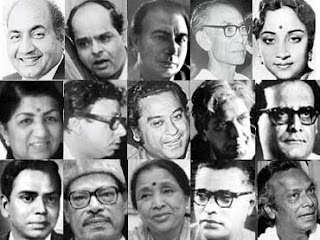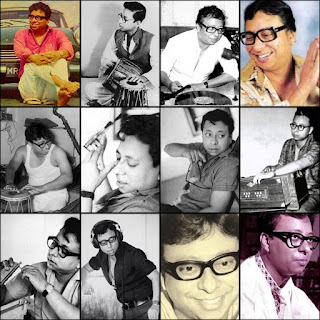PART 10 OF 10: PANCHAM, ROCK AND ROLL, AND TRENDSETTERS
When did Pancham's youthful exuberance start expressing itself through his music? Was it from his first movie or did he pick it up along the way?
He had certainly shown glimpses of it before, but I think it was with the 1973 film, 'Yaadon Ki Baaraat', that he went totally "yahoo". The energy and the verve of his melodies, which is what his fans relish about him even to this day, reached another level after scoring for this Nasir Husain classic.
It is not like he was a straight jacket before this. After all, he had made Shammi Kapoor reach ecstatic states with 'Aaja aaja' and 'O haseena zulfon wali' in 'Teesri Manzil'. That was in 1966. With Asha Bhosle's crooning and Helen's hip-shaking (and men's heart skipping), he started a new genre in Hindi film music, after the raunchy 'Piya tu ab tu aaja'. With 'Yeh diwani yeh jawani', ‘Chala jaata hoon’ and the like, he made Kishoreda go zanier than before (and that is saying a lot, if you knew Kishore). Or in 1971, when he doped up an entire nation with 'Dum maro dum', to a point where he made Tamils, at the very peak of their anti-Hindi agitation, take a break and sway to the youth's anthem. Yes, he did that, this, and the other. But in 'Yaadon Ki Baaraat', he turned unapologetically rock and roll.
1973 was a year that needed all that zaniness and rock-and-rollery to loosen things up. Although Prime Minister Indira Gandhi's job approval rating was almost at its highest what with a war victory under her belt and a Green Revolution that was starting to reap benefits, things were going to get rough for her. The economy was showing signs of giving in and then she received a further jolt from the highest court of the land. Kesavananda Bharati, the Shankaracharya of the Edneer Mutt in Kerala, filed suit against the State fighting to protect his Mutt's land, which the state government was trying to usurp through the land reform act. A thirteen-judge Supreme Court bench after a six-month deliberation, ruled 7-6 in Bharati's favor and established that the fundamental premise of Kerala's land reform act was unconstitutional. It further ruled that no parliament or legislature can tinker with the basic structure of the Indian constitution. That sounds rather innocuous but it infuriated Indira Gandhi no end and delighted the Indian jurisprudence, which hailed the court and the Swamiji as the savior of Indian democracy. (I am not sure if the Swamiji got his land back. That is besides the point, I guess.)
Close on the heels of this judgment (and perhaps because of it), Prime Minister Indira Gandhi defied protocol and superseded three senior judges to promote AN Ray (who had voted against Kesavananda Bharati, incidentally) as the Chief Justice of the Indian Supreme Court. A new judge appointed to the Supreme Court that year (VR Krishna Iyer) would eventually dismember Indira from the Lok Sabha forcing her to declare the infamous Emergency of 1975. So, 1973 sowed the seeds for a lot of chaos to come.
On the movies front, 1973 was a trendsetting year like no other in Indian film history. I am no Theodore Baskaran but I am making a rather serious assertion here and I have my reasons. Hindi films produced three blockbusters that year, which created templates and trends for a thousand movies to follow.
Let’s start with ‘Bobby’. It seems tough to believe now but 'Bobby' was the first teenybop romance in fifty years of Indian cinema. Yes. This was the first time that we decided to show young people romancing on screen. Till then, Indian movies cast hairy-chested men with receding hairlines and make-up infested women with hideous bouffant, bob, or bangs, that were near middle-age, meeting in college, running around trees and performing teenage acts. It took a Raj Kapoor to make the nation realize that it is safe to cast actual teenagers to do that. Average age of heroes and heroines was slashed by ten. Fairness creams and Liril ads were made just for Young India. Khap Panchayats were established to stop teenagers from indulging in un-Indian things. Okay. You know I am making up history here. My point is romantic movies would never be the same again - at least in Hindi. Raj Kapoor deserved a Dada Saheb Phalke award just for that. No, I am not being flippant here. If you don't think of what Kapoor did as a big deal, talk to your neighborhood South Indian friend and ask him or her (nicely) about the southern movies of the seventies and eighties. Since 'Bobby' was less of a trendsetter in the South, southerners had to endure the trauma of watching the likes of MGR, NTR and Sivaji Ganesan partake in college romances till their superannuation. They refused to graduate from college like students in JNU. The audience had to take matters into their own hands and conspire to make a couple of them Chief Ministers of their respective states so that we don't have to bear the ignominy of seeing them on screen as college students. The sacrifices South Indians have had to make for their movie stars. That was 'Bobby'.
'Zanjeer' was the fourth-highest grosser of 1973. The Prakash Mehra movie established the template for the other relic of the seventies and eighties: the 'angry young man' movies. There was much to be angry about then. Judges and politicians were fighting pitch battles with each other (as discussed earlier). The gulf oil crisis resulted in a steep increase in the unemployed and the disgruntled young. Inflation had touched thirty-three percent. Life sucked. The tall, gawky Amitabh Bachchan tapped into the emotion of the nation to stupendous success for himself. A thousand copycat acts were to follow in every Indian language. 'Sholay', the baap of all ‘angry’ movies, released in 1975 and sealed the fate of romantic movies, and hence melodious music, at least for another generation. And that is why, my friends, my Golden Age ends with 1975.
'Yaadon Ki Baaraat' didn't earn as much moolah as 'Bobby' and 'Zanjeer', but if you ask me, it was was a bigger influence on Indian mainstream movies than the other two. Every Indian masala movie made since 1973 is 'Yaadon ki Baaraat' at its core. Incredulous but fast-paced screenplays, large boisterous families lost (maybe deliberately) in a mela, the clumsy brother with two left feet (sorry I had to say that about Vijay Arora), ugly villains that get the cool chicks, loads of sentiment and crying over spilt milk, a life of accidents and coincidences; and then the family reunited in the last reel via a family song. It was 'paisa vasool' cinema, like no other. It was like devouring a full-course, banana-leaf lunch in Hotel Saravana Bhavan, Chennai, on a hot summer day. Your artistic stomach was filled to the brim and ready to burst at the seams. But it was utterly satisfying.
I will go with the rock-and-rolly song of 'Yaadon Ki Baaraat' that captures the spirit of RD Burman of the seventies: 'Lekar hum deewana dil'. Kishore and Asha absolutely nail this one.
The song features cutesy Neetu Singh in a mini skirt and Tariq Khan in a shiny shirt and bellbottoms, giving serious competition to his long-lost brother, Vijay Arora, in the clumsiness department. A word about Asha Bhosle, who is one of the greatest singers in Indian movies ever. You wonder how she managed that with her legendary elder sister, Lata's, shadow looming large. This song and ten thousand other songs prove how. Asha studiedly nurtured a unique style and differentiated herself right from the outset. In her sixty year career, there is not a genre that she has not aced - some would argue, more adroitly than Lata did; and they would have a point. But there is no other genre that she mastered better than the peppy, raunchy, pop/cabaret item number. She just killed those. Here is one!
Ladies and gentlemen, that is song number ten and I am done! The Golden Age comes to a grand, seventies-style, glitzy close with this song. I hope you enjoyed experiencing the music and the times of the yore as much as I did writing about it. Thanks for staying with me through this journey. Good luck and Godspeed.
<<PART 9: YEH KYA HUA? KAISE HUA?












Comments
Post a Comment